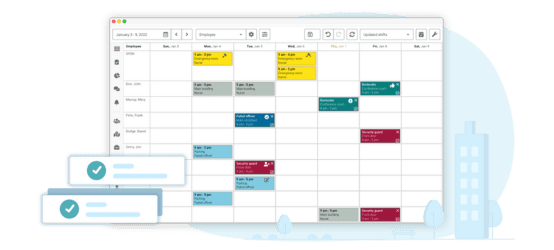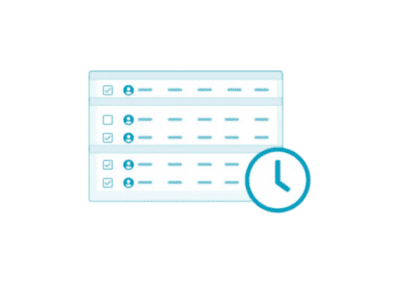Calling all schedulers! Need some employee scheduling tips? Then you’re in the right place. As experts in the workforce management field, we’re here to share our top tips with you.
First of all, let’s discuss why employee scheduling is so complex in the first place.
- First of all, shift work makes scheduling complex as the scheduler has to balance the needs of the business along with employee availability.
- Getting the right balance between staffing at sites, overtime expenses and employee burnout is a critical part of creating schedules.
- Staff working across multiple sites at different locations.
- Ensuring remote workers are on site and checking in on time.
- Managing last-minute sick calls or no-shows and trying to find a replacement for them.
Let’s look at some of our top employee scheduling tips that help solve the above issues.
Employee Scheduling Tips:
Identify your business needs:
Take a look at your past schedules and see what you needed then. Ask yourself, how many employees are needed for a shift? Are there certain qualifications required? How long does the shift need to be to get the work done? Look at your busy periods and make note if additional workers were required. Once you’ve analyzed your past information you can use it for your future schedules. As well as that, it helps you see where you may need to improve for the future
Have a backup plan:
Last-minute schedule changes happen all the time. Employees may have an emergency and can’t come to work. Employees call in sick or you may simply get a no-show with no explanation. How you handle these complexities is vital to a successful schedule. How can you ensure your shifts are covered if someone can’t come in? You may need to consider the time of year and have preparations in place. For example, flu season can cause a lot of people to be sick or summer is usually the time when people request the most time off. When you know these patterns it can help build a strong schedule.
As well as that, there are tools you can use for your scheduling, like the Celayix Find a Replacement tool. This tool is part of our employee scheduling software and allows you to quickly find a replacement employee with the click of a button. You can filter out unsuitable employees and our system will only show those that are qualified for the shift!
Analyze your workforce:
This is another one of our top employee scheduling tips. You need to really understand the strengths and weaknesses that make up your workforce. Keep in mind what skills and qualifications are required for a shift. For example, many event companies require staff to be health and safety trained.
As well as that, make sure and ask about employee availability. Some employees may like working night shifts so they have the day to spend with family or vice versa. Employees who are still studying may need the day off so they can attend classes. You won’t always be able to create a schedule that suits everyone all the time. However, by being aware of their needs and requests you can try your best to let the schedule work for everyone. Another thing to be aware of is who works well together. Not all workers will get along so it’s important to keep an eye on employees who clash. Management is another key part of this too. Try finding the right manager for the right team. Everyone has different management styles and certain styles might not work for all workers. We know getting the balance right is hard but it’s definitely worth the effort.
Provide clear Communication:

How you communicate, what you communicate, and when you communicate is super important. Send schedules to employees with plenty of notice. This gives them time to arrange their social lives around their schedule and make plans outside of work – which contributes to a healthy work-life balance. It also gives you time to make necessary changes and find replacement staff if needed. How do you currently communicate your schedule? Is it through text message, spreadsheet, or piece of paper stuck on the wall? If this is the case you should look for a better alternative. Employee scheduling software like Celayix has an employee app where you can upload the schedule. Then send an instant notification to your teams to let them know. They can look at all their previous schedules and even use the app to check in and out and for time off requests! Definitely, a better option as everything is saved and secure in the cloud. Check out more info on the Celayix mobile app here.
Give employees control:
We get it, sometimes it’s hard to give other people control over creating schedules. Nevertheless, you should trust us when we say it really makes a difference! It even saves you time and hassle when creating schedules too. One of our top employee scheduling tips is to put some power into the hands of your employees. You can do this by allowing employees to contribute to the schedule. Let your team do some of the work! Our workforce management software has a self-scheduling tool as well as a shift bidding tool. Self-scheduling is pretty self-explanatory and allows employees to schedule themselves for open shifts. For shift bidding, employees can bid on available shifts and the scheduler can ultimately approve or deny who gets to work it. This system is great for event companies when they need staff for a certain event.
Build in Flexibility:
It may not always be possible but allowing flexibility in the schedule is a great way to keep your employees happy. In fact, a study done by Skynova found that in a survey of 1,000 employees, half of the respondents said a flexible schedule was more important to them than their salary. This shows us how highly valued flexibility is in your workforce. You will benefit from improved employee retention and your employees will be more motivated and happier at work.
Flexible workplaces will look different in various companies but they can look like:

- Employees choosing where they work from e.g. working from home
- Input into their schedule e.g. getting to choose when they start and finish work
From the company’s point of view, you can look at areas like:
- Part time work
- Remote work
- 4 day work weeks
- Alternating schedules
- Once off shifts
- Seasonal employment
Get feedback from your team and find out what they want and what works best for them. Your workforce will be all the happier and more productive for it!
To conclude…
We know there are a lot of moving parts to manage when creating a schedule for your workforce. However, if you implement our top 6 employee scheduling tips your process will improve significantly! If you would discuss employee scheduling with leading workforce management experts then we’d love to hear from you. Get in touch with sales here.





